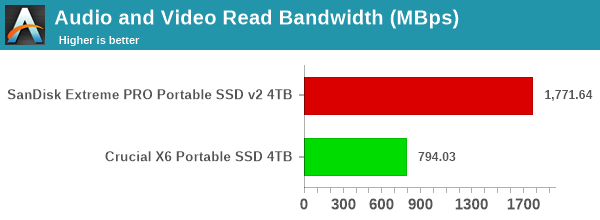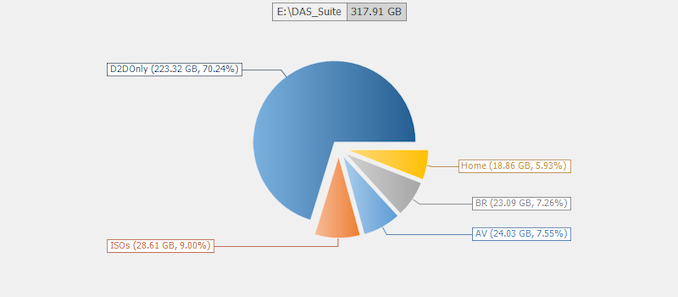SanDisk Extreme PRO and Crucial X6 4TB Portable SSDs Review: Contrasting High-Capacity Storage Options
by Ganesh T S on August 18, 2021 9:30 AM EST- Posted in
- Storage
- SSDs
- Western Digital
- DAS
- NVMe
- Type-C
- USB 3.2 Gen 2x2
- Portable SSDs
AnandTech DAS Suite - Benchmarking for Performance Consistency
Our testing methodology for storage bridges / direct-attached storage units takes into consideration the usual use-case for such devices. The most common usage scenario is the transfer of large amounts of photos and videos to and from the unit. Other usage scenarios include the use of the unit as a download or install location for games and importing files directly from it into a multimedia editing program such as Adobe Photoshop. Some users may even opt to boot an OS off an external storage device.
The AnandTech DAS Suite tackles the first use-case. The evaluation involves processing five different workloads:
- AV: Multimedia content with audio and video files totalling 24.03 GB over 1263 files in 109 sub-folders
- Home: Photos and document files totalling 18.86 GB over 7627 files in 382 sub-folders
- BR: Blu-ray folder structure totalling 23.09 GB over 111 files in 10 sub-folders
- ISOs: OS installation files (ISOs) totalling 28.61 GB over 4 files in one folder
- Disk-to-Disk: Addition of 223.32 GB spread over 171 files in 29 sub-folders to the above four workloads (total of 317.91 GB over 9176 files in 535 sub-folders)
Except for the 'Disk-to-Disk' workload, each data set is first placed in a 29GB RAM drive, and a robocopy command is issue to transfer it to the external storage unit (formatted in exFAT for flash-based units, and NTFS for HDD-based units).
robocopy /NP /MIR /NFL /J /NDL /MT:32 $SRC_PATH $DEST_PATH
Upon completion of the transfer (write test), the contents from the unit are read back into the RAM drive (read test) after a 10 second idling interval. This process is repeated three times for each workload. Read and write speeds, as well as the time taken to complete each pass are recorded. Whenever possible, the temperature of the external storage device is recorded during the idling intervals. Bandwidth for each data set is computed as the average of all three passes.
The 'Disk-to-Disk' workload involves a similar process, but with one iteration only. The data is copied to the external unit from the CPU-attached NVMe drive, and then copied back to the internal drive. It does include more amount of continuous data transfer in a single direction, as data that doesn't fit in the RAM drive is also part of the workload set.

The two SSDs meet the advertised performance numbers across almost all workloads, keeping in mind that some components involve a large number of small files that tend to bring down the numbers a bit. Power users may want to dig deeper to understand the limits of each device. To address this concern, we also instrumented our evaluation scheme for determining performance consistency.
Performance Consistency
Aspects influencing the performance consistency include SLC caching and thermal throttling / firmware caps on access rates to avoid overheating. This is important for power users, as the last thing that they want to see when copying over 100s of GB of data is the transfer rate going down to USB 2.0 speeds.
In addition to tracking the instantaneous read and write speeds of the DAS when processing the AnandTech DAS Suite, the temperature of the drive was also recorded. In earlier reviews, we used to track the temperature all through. However, we have observed that SMART read-outs for the temperature in NVMe SSDs using USB 3.2 Gen 2 bridge chips end up negatively affecting the actual transfer rates. To avoid this problem, we have restricted ourselves to recording the temperature only during the idling intervals. The graphs below present the recorded data.
| AnandTech DAS Suite - Performance Consistency | |
| TOP: | BOTTOM: |
 |
|
 |
|
The first three sets of writes and reads correspond to the AV suite. A small gap (for the transfer of the video suite from the internal SSD to the RAM drive) is followed by three sets for the Home suite. Another small RAM-drive transfer gap is followed by three sets for the Blu-ray folder. This is followed up with the large-sized ISO files set. Finally, we have the single disk-to-disk transfer set. The three write sets for each component are remarkably consistent across both SSDs. The controller behavior in the X6 for the disk-to-disk write case is interesting to analyze - With 32 parallel threads copying data from different folders, it appears that the controller gets a bit overwhelmed, hitting only around 550 MBps, before recovering and stepping up to around the expected 800 MBps mark. The SanDisk Extreme PRO v2, on the other hand, handles the 32-thread copy well and drops down only as the host system tries to catch up and send across more small-sized files. Once past those dips, the performance numbers stay at around 1.6 GBps for the rest of the write workload. On the temperature front, both units behave similarly, though the final temperature of the SanDisk unit is worth appreciating - despite the higher performance, the peak of 61C was lower than the X6's 62C.











20 Comments
View All Comments
eastcoast_pete - Wednesday, August 18, 2021 - link
I find it unfortunate that neither manufacturer found a way to integrate at least a few inches/centimeters of cable with USB connector into the case. You could still have another port/connector for an actual cable, but having let's say 6 inches/ 15 cm of cable with plug always attached (cable stored in a groove around the case) avoids the situation when one really needs to back up or save some larger files in a pinch, but then the cable is MIA. That's one of the reasons why USB sticks are so handy (can't lose the connector, you either have the stick or you don't), but they don't reach the speed or capacity of these external SSDs.damianrobertjones - Wednesday, August 18, 2021 - link
cables can snap off, break etc. Then again so can the connector. I'd rather buy x3 cables for a sensible price. one at work, one at home, one to travel.meacupla - Wednesday, August 18, 2021 - link
ew, no, that's disgustingIntegrated cable is easily the worst and cheapest way to design things. Cables are, easily, the most likely connection to fail, and you want to integrate that?
The only thing worse is a micro USB3.0 connector
USB 3.0 A or USB-C, male, with a dust cover is an acceptable alternative, but female USB-C connector is so convenient, why would you use anything else?
flyingpants265 - Wednesday, August 18, 2021 - link
Integrate a removable cable. Problem solved.watersb - Wednesday, August 18, 2021 - link
Better: integrate a microUSB 3.0 cable. Now you have two problems.whatthe123 - Wednesday, August 18, 2021 - link
or you could just have a slot for the removable cable instead of adding another point of failureaparangement - Wednesday, August 18, 2021 - link
I think thermal capacity is the major bottleneck. You either live with slow USB stick which is cool and light, or PSSD with seperate cable, since the increased weight makes the connector more vulnerable.Sivar - Wednesday, August 18, 2021 - link
It seems both products are priced reasonably. It's rare that I really need a portable drive to be Tesla quick, so I think the Crucial drive is a great deal for me, perhaps for most people.evanh - Wednesday, August 18, 2021 - link
The X6 fails in the sequential bulk copy dept. That's a primary use case for external storage devices.ganeshts - Friday, August 20, 2021 - link
It performs great for up to 800GB of continuous traffic. Can't imagine a casual user transferring that much amount of data in one go. As I mentioned in the concluding section, power users with such demanding requirements have to be ready to fork out a premium for the full-capacity consistency that the SanDisk Extreme PRO v2 provides.